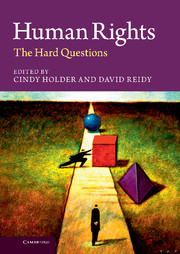Book contents
- Frontmatter
- Contents
- Figure
- List of table
- Notes on contributors
- Introduction
- Part I What are human rights?
- Part II How do human rights relate to group rights and culture?
- 4 The significance of cultural differences for human rights
- 5 Groups and human rights
- 6 Entangled
- 7 What does cultural difference require of human rights?
- Part III What do human rights require of the global economy?
- Part IV How do human rights relate to environmental policy?
- Part V Is there a human right to democracy?
- Part VI What are the limits of rights enforcement?
- Part VII Are human rights progressive?
- Index
- References
4 - The significance of cultural differences for human rights
Published online by Cambridge University Press: 05 May 2013
- Frontmatter
- Contents
- Figure
- List of table
- Notes on contributors
- Introduction
- Part I What are human rights?
- Part II How do human rights relate to group rights and culture?
- 4 The significance of cultural differences for human rights
- 5 Groups and human rights
- 6 Entangled
- 7 What does cultural difference require of human rights?
- Part III What do human rights require of the global economy?
- Part IV How do human rights relate to environmental policy?
- Part V Is there a human right to democracy?
- Part VI What are the limits of rights enforcement?
- Part VII Are human rights progressive?
- Index
- References
Summary
Introduction: whether culture represents a challenge to human rights
In the twentieth century, international human rights standards emerged in the global arena. There was tremendous excitement about their potential to protect individuals from atrocities and to help guarantee a decent quality of life for all. From the beginning there were questions about the philosophical foundations of human rights. In particular, there has been considerable attention paid to the challenge culture poses to the validity of international human rights. Because human rights notions were seen as being derived from the Enlightenment tradition, this seemed to imply that human rights are “Western” or “Eurocentric” (Pannikkar 1982). If, in fact, they did reflect a cultural bias, that might undermine the legitimacy of this new regime.
During the drafting of the initial human rights instruments collectively known as “the International Bill of Rights,” delegates came together from diverse countries. Insofar as there was representation from different parts of the world at the meetings, one might have thought this would mitigate the impact of such a critique. Nevertheless, the challenge from cultural relativism remained.
- Type
- Chapter
- Information
- Human RightsThe Hard Questions, pp. 79 - 99Publisher: Cambridge University PressPrint publication year: 2013

